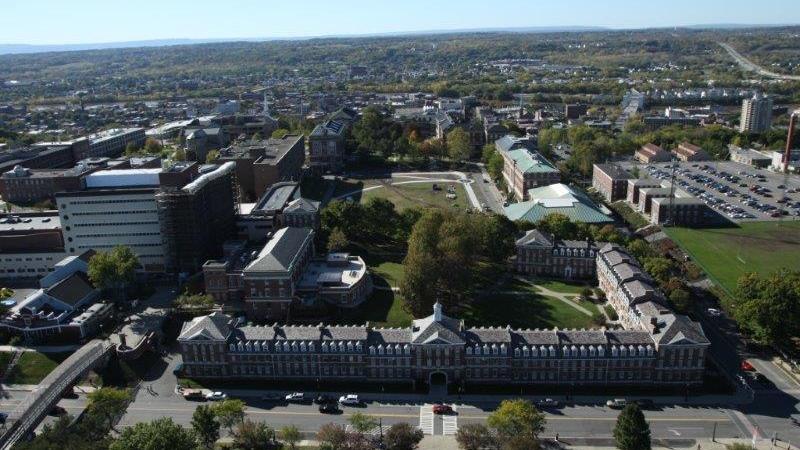Albany-Schenectady-Troy Region Ranked in 11th Place
October 15, 2014

Troy, N.Y. – According to the American Institute for Economic Research (AIER), these days the “college experience” is about more than simply attending a top-notch university. The city or town where the school is located is also important. Recent data compiled by the organization ranked the 20 best small cities for college students, with the Albany-Schenectady-Troy region coming in at number 11 on the list.
Quiet and scenic, yet full of all the conveniences of a self-contained city, the Rensselaer Polytechnic Institute Troy campus is a blend of modern style and classic charm. Founded in 1824, Rensselaer is America’s oldest technological research university.
Today, Rensselaer is home to 5,544 undergraduate students and 1,389 graduate students on the Troy and Hartford, Connecticut campuses. The Institute offers degrees from five schools: Engineering; Science; Architecture; Humanities, Arts, and Social Sciences; and the Lally School of Management; as well as an interdisciplinary degree in Information Technology and Web Science.
Rensselaer programs serve undergraduates, graduate students, and working professionals around the world. Nearly 29 percent of undergraduate students this year are from areas outside of the Northeast. First-year students hail from 43 states, in addition to the District of Columbia and Puerto Rico, and from countries all around the world. This year, the Institute welcomed 246 graduate international students from China, India, Turkey, Vietnam, and 35 other countries.
The Institute offers more than 145 programs at the bachelor’s, master’s, and doctoral levels. Students are encouraged to work in interdisciplinary programs that allow them to combine scholarly work from several departments or schools. The university also provides rigorous, engaging, interactive learning environments and campus-wide opportunities for leadership, collaboration, and creativity. Research conducted at Rensselaer addresses some of the world’s most pressing technological challenges – from energy security and sustainable development to biotechnology and human health.
The AIER College Destinations Index data focused on various metro areas across the country, measuring the informal learning environment. The organization looked into 12 key criteria in four categories that impact the student experience in areas that include: student life, culture, economic health, and opportunity. According to organization, “The people students meet, the places they go, and the jobs they may hold are essential supplements to formal education.” Data was collected and ranked for college towns with populations under 250,000 residents.
The Albany-Schenectady-Troy region received high marks in the areas of entrepreneurship, innovation, and the arts. Rensselaer continues to attract students with a special interest in discovery, innovation, and interdisciplinary study. A Rensselaer education is about breaking down boundaries, and joining a learning community where students and faculty members representing diverse academic interests collaborate across disciplines.
In addition, technology transfer and entrepreneurship have long been at the heart of Rensselaer’s core mission “to apply science to the common purposes of life,” through creative discovery, design, invention, and commercialization. Over the past several years, Rensselaer has reaffirmed and updated its academic distinction in technology application by cultivating an entrepreneurial ecosystem to ignite innovation and spark economic growth throughout the region.
In Troy, N.Y., the greater Capital Region, and the Hartford, C.T., metropolitan area, the Institute is keenly aware of its responsibilities to its nearest neighbors and of the power of collaborative approaches to shared goals.
Rensselaer President Shirley Ann Jackson underscores the importance of active partnership with the larger community in the term “communiversity”—a vision of the way institutions of higher learning and the cities, towns, and counties that serve as their homes can and should work together to ensure the viability and vibrancy of their shared communities.
In addition, the recent PayScale 2014-15 College Salary Report noted that graduates of Rensselaer command some of the highest salaries of any undergraduate degree holders in the nation.
The PayScale report is the latest recognition of the long-held reputation of Rensselaer as one of the nation’s top universities. In August, USA Today ranked Rensselaer as fifth on the list of “Top 10 Engineering Colleges in the United States,” and Forbes ranked Rensselaer as eleventh on the list for most entrepreneurial universities. In September, U.S. News & World Report ranked Rensselaer 42 among all universities in the United States.
The recent series of acknowledgements reinforces what the Institute has seen in its most recent admissions cycle: the demand for a Rensselaer education has never been higher.
As it approaches its bicentennial anniversary, the Institute is defining The New Polytechnic: a new paradigm for teaching, learning, and research — a view of the technological research university as a fresh collaborative endeavor across disciplines, sectors, and global regions that leads by using advanced technologies to unite a multiplicity of disciplines and perspectives, in order to take on large, multifaceted challenges. For more information, visit: http://rpi.edu/bridgetobicentennial/
For more information, and to view the American Institute of Economic Research Destinations Index, visit: https://www.aier.org/2015-college-destinations-index-top-20-college-towns